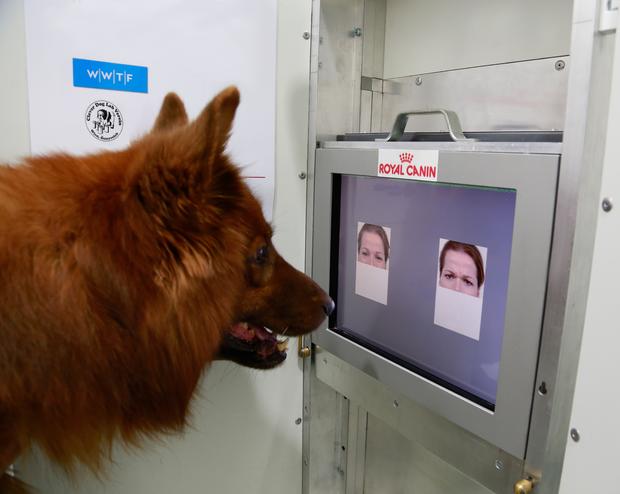Happy? Mad? Your dog can tell just by looking at you
Potty training dogs has a lot to do with raising your voice and pointing fingers. But maybe a smile or a frown is the way to go.
Until now, that might seem like something only Cesar Millan of "Dog Whisperer" fame would advise. But now a study in Current Biology has put some hard science behind it, finding that dogs can tell the difference between happy and angry faces.
"Our study demonstrates that dogs can distinguish angry and happy expressions in humans, they can tell that these two expressions have different meanings, and they can do this not only for people they know well, but even for faces they have never seen before," says Ludwig Huber, senior author and head of the group at the University of Veterinary Medicine Vienna's Messerli Research Institute.
This is the first study to show that an animal other than humans can discriminate between emotional expressions of another species. Not only did the dogs make the right choices but the scientists said they were also able to transfer what they learned in learning new cues.
The researchers brought in dogs - mostly border collies but also a German shepherd, fox terrier and golden retriever - and trained them to discriminate between images of the same person making happy and angry faces which were exhibited mostly in their mouths and eyes. Then, 11 were brought in front of a screen and shown an entirely new set of pictures. They tapped the image of the test expression - happy or angry - with their snout and were rewarded with a treat when made the right choice. (The video above shows the experiment in action.)
The dogs were able to choose the angry and happy faces of white women - chosen because their owners were white women - more often than if they did it by chance, though they did better with the happy ones.
Müller said the dogs might have been slower to respond to the angry faces because they already understand that messing with an angry human is best avoided.
"I would not say that they were better at identifying happy than angry faces. Rather, they learned the discrimination task quicker if they were rewarded for touching the happy half-face than if they were rewarded for touching the angry half-face," Müller said, referring to the fact that images showed only portions of the faces. "This gives a hint that the dogs may not only have discriminated the two facial expressions, they may to some extent also have recognized what they mean."
Dogs made a good test case because there is a wealth of data showing they respond to human cues and can differentiate between a familiar person and a stranger. But until now, tests demonstrating their being able to differentiate between different emotions had not been "completely convincing."
The findings come at a time when emotions in animals have become a hot topic in biology circles, with many saying that being able to understand their feelings is crucial to ensuring animals - especially those in captivity like zoos or being raised on farms - are given proper care.
But whether this could apply to other species remains an open question. The success of the dogs, the researchers acknowledged, might be due to the fact that Fido has this unique bond with humans going back at least 15,000 years.
"At this point we do not know whether the impressive performance of some dogs in our study is purely due to their extensive experience in interaction with humans, or whether domestication played a role as well, or whether maybe social species in general are attentive to emotional expressions of others, and learn to discriminate different expressions in others," said Corsin Müller, another co-author at the University of Veterinary Medicine Vienna.
"These questions can be addressed by testing other species with the task we presented to the dog," she told CBS News by email. "For example, other domesticated species and other animals that have a lot of exposure to humans. Particularly interesting will be testing the hand-raised wolves ... Also, I would expect that some great apes (at least enculturated individuals) will be able to solve the task as well."
Jaak Panksepp, chair of animal well-being science at Washington State University who did not take part in the study, called the research "a compelling demonstration that our canine companions are able to discriminate human emotional faces."
"This project goes a long way demonstrating how sensitive domestic dogs are to our emotional cues," he said, adding that it remains possible that animals that have been selectively bred to respond to human cues are more adept at such tasks.
"It is becoming increasingly clear that we share fundamental emotional processes with other animals which may allow us to deploy animal models in new ways to understand and, for instance, treat chronic affective changes in humans that lead to depression," Panksepp said.
In the future, the scientists plan to study how dogs themselves express emotions and how their emotions are influenced by the emotions of their owners or other humans.
"We expect to gain important insights into the extraordinary bond between humans and one of their favorite pets, and into the emotional lives of animals in general," Müller said.
